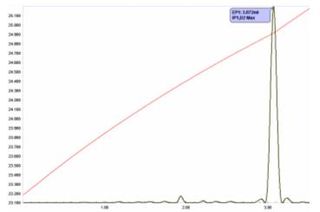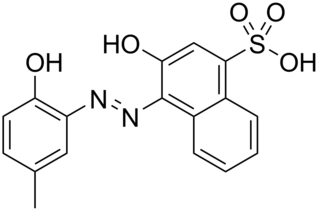Related Research Articles

Titration is a common laboratory method of quantitative chemical analysis to determine the concentration of an identified analyte. A reagent, termed the titrant or titrator, is prepared as a standard solution of known concentration and volume. The titrant reacts with a solution of analyte to determine the analyte's concentration. The volume of titrant that reacted with the analyte is termed the titration volume.
A pH indicator is a halochromic chemical compound added in small amounts to a solution so the pH (acidity or basicity) of the solution can be determined visually or spectroscopically by changes in absorption and/or emission properties. Hence, a pH indicator is a chemical detector for hydronium ions (H3O+) or hydrogen ions (H+) in the Arrhenius model. Normally, the indicator causes the color of the solution to change depending on the pH. Indicators can also show change in other physical properties; for example, olfactory indicators show change in their odor. The pH value of a neutral solution is 7.0 at 25°C (standard laboratory conditions). Solutions with a pH value below 7.0 are considered acidic and solutions with pH value above 7.0 are basic. Since most naturally occurring organic compounds are weak electrolytes, such as carboxylic acids and amines, pH indicators find many applications in biology and analytical chemistry. Moreover, pH indicators form one of the three main types of indicator compounds used in chemical analysis. For the quantitative analysis of metal cations, the use of complexometric indicators is preferred, whereas the third compound class, the redox indicators, are used in redox titrations (titrations involving one or more redox reactions as the basis of chemical analysis).

In chemistry, there are three definitions in common use of the word "base": Arrhenius bases, Brønsted bases, and Lewis bases. All definitions agree that bases are substances that react with acids, as originally proposed by G.-F. Rouelle in the mid-18th century.

Ethylenediaminetetraacetic acid (EDTA), also called edetic acid after its own abbreviation, is an aminopolycarboxylic acid with the formula [CH2N(CH2CO2H)2]2. This white, water-soluble solid is widely used to bind to iron (Fe2+/Fe3+) and calcium ions (Ca2+), forming water-soluble complexes even at neutral pH. It is thus used to dissolve Fe- and Ca-containing scale as well as to deliver iron ions under conditions where its oxides are insoluble. EDTA is available as several salts, notably disodium EDTA, sodium calcium edetate, and tetrasodium EDTA, but these all function similarly.
Complexometric titration is a form of volumetric analysis in which the formation of a colored complex is used to indicate the end point of a titration. Complexometric titrations are particularly useful for the determination of a mixture of different metal ions in solution. An indicator capable of producing an unambiguous color change is usually used to detect the end-point of the titration. Complexometric titration are those reactions where a simple ion is transformed into a complex ion and the equivalence point is determined by using metal indicators or electrometrically.
The equivalence point, or stoichiometric point, of a chemical reaction is the point at which chemically equivalent quantities of reactants have been mixed. For an acid-base reaction the equivalence point is where the moles of acid and the moles of base would neutralize each other according to the chemical reaction. This does not necessarily imply a 1:1 molar ratio of acid:base, merely that the ratio is the same as in the chemical reaction. It can be found by means of an indicator, for example phenolphthalein or methyl orange.

Eriochrome Black T is a complexometric indicator that is used in complexometric titrations, e.g. in the water hardness determination process. It is an azo dye. Eriochrome is a trademark of Huntsman Petrochemical, LLC.
Iodometry, known as iodometric titration, is a method of volumetric chemical analysis, a redox titration where the appearance or disappearance of elementary iodine indicates the end point.

Murexide (NH4C8H4N5O6, or C8H5N5O6·NH3), also called ammonium purpurate or MX, is the ammonium salt of purpuric acid. It is a purple solid that is soluble in water. The compound was once used as an indicator reagent. Aqueous solutions are yellow at low pH, reddish-purple in weakly acidic solutions, and blue-purple in alkaline solutions.
In analytical chemistry, quantitative analysis is the determination of the absolute or relative abundance of one, several or all particular substance(s) present in a sample.

A thermometric titration is one of a number of instrumental titration techniques where endpoints can be located accurately and precisely without a subjective interpretation on the part of the analyst as to their location. Enthalpy change is arguably the most fundamental and universal property of chemical reactions, so the observation of temperature change is a natural choice in monitoring their progress. It is not a new technique, with possibly the first recognizable thermometric titration method reported early in the 20th century. In spite of its attractive features, and in spite of the considerable research that has been conducted in the field and a large body of applications that have been developed; it has been until now an under-utilized technique in the critical area of industrial process and quality control. Automated potentiometric titration systems have pre-dominated in this area since the 1970s. With the advent of cheap computers able to handle the powerful thermometric titration software, development has now reached the stage where easy to use automated thermometric titration systems can in many cases offer a superior alternative to potentiometric titrimetry.
In analytical chemistry, potentiometric titration is a technique similar to direct titration of a redox reaction. It is a useful means of characterizing an acid. No indicator is used; instead the electric potential is measured across the analyte, typically an electrolyte solution. To do this, two electrodes are used, an indicator electrode and a reference electrode. Reference electrodes generally used are hydrogen electrodes, calomel electrodes, and silver chloride electrodes. The indicator electrode forms an electrochemical half-cell with the interested ions in the test solution. The reference electrode forms the other half-cell.
In coordination chemistry, a stability constant is an equilibrium constant for the formation of a complex in solution. It is a measure of the strength of the interaction between the reagents that come together to form the complex. There are two main kinds of complex: compounds formed by the interaction of a metal ion with a ligand and supramolecular complexes, such as host–guest complexes and complexes of anions. The stability constant(s) provide(s) the information required to calculate the concentration(s) of the complex(es) in solution. There are many areas of application in chemistry, biology and medicine.

Fast Sulphon Black F is a complexometric indicator used with EDTA, almost exclusively used in copper complexation determination.

Calmagite is a complexometric indicator used in analytical chemistry to identify the presence of metal ions in solution. As with other metal ion indicators calmagite will change color when it is bound to an ion. Calmagite will be wine red when it is bound to a metal ion and may be blue, red, or orange when it is not bound to a metal ion. Calmagite is often used in conjunction with EDTA, a stronger metal binding agent. This chemical is also used in the quantitation of magnesium in the clinical laboratory.
Conductometry is a measurement of electrolytic conductivity to monitor a progress of chemical reaction. Conductometry has notable application in analytical chemistry, where conductometric titration is a standard technique. In usual analytical chemistry practice, the term conductometry is used as a synonym of conductometric titration while the term conductimetry is used to describe non-titrative applications. Conductometry is often applied to determine the total conductance of a solution or to analyze the end point of titrations that include ions.
Binding selectivity is defined with respect to the binding of ligands to a substrate forming a complex. Binding selectivity describes how a ligand may bind more preferentially to one receptor than another. A selectivity coefficient is the equilibrium constant for the reaction of displacement by one ligand of another ligand in a complex with the substrate. Binding selectivity is of major importance in biochemistry and in chemical separation processes.
Equilibrium chemistry is concerned with systems in chemical equilibrium. The unifying principle is that the free energy of a system at equilibrium is the minimum possible, so that the slope of the free energy with respect to the reaction coordinate is zero. This principle, applied to mixtures at equilibrium provides a definition of an equilibrium constant. Applications include acid–base, host–guest, metal–complex, solubility, partition, chromatography and redox equilibria.
Cerimetry or cerimetric titration, also known as cerate oximetry, is a method of volumetric chemical analysis developed by Ion Atanasiu. It is a redox titration in which an iron(II)–1,10-phenanthroline complex (ferroin) color change indicates the end point. Ferroin can be reversibly discolored in its oxidized form upon titration with a Ce4+ solution. The use of cerium(IV) salts as reagents for volumetric analysis was first proposed in the middle of 19th century, but systematic studies did not start until about 70 years later. Standard solutions can be prepared from different Ce4+ salts, but often cerium sulfate is chosen.

Calconcarboxylic acid is an azo dye that is used as an indicator for complexometric titrations of calcium with ethylenediaminetetraacetic acid (EDTA) in the presence of magnesium. Structurally, it is similar to eriochrome blue black R, which is obtained from calconcarboxylic acid by decarboxylation and reaction with sodium hydroxide.
References
- ↑ Flaschka, H.; Schwarzenbach, G.; Schwarzenbach, Gerold (1969). Complexometric titrations. London: Methuen. ISBN 0-416-19290-4.
- ↑ M. A. Malati (1999). Experimental Inorganic/Physical Chemistry: An Investigative, Integrated Approach to Practical Project Work (Horwood Series in Chemical Science). Albion/Horwood Pub. p. 20. ISBN 1-898563-47-0.